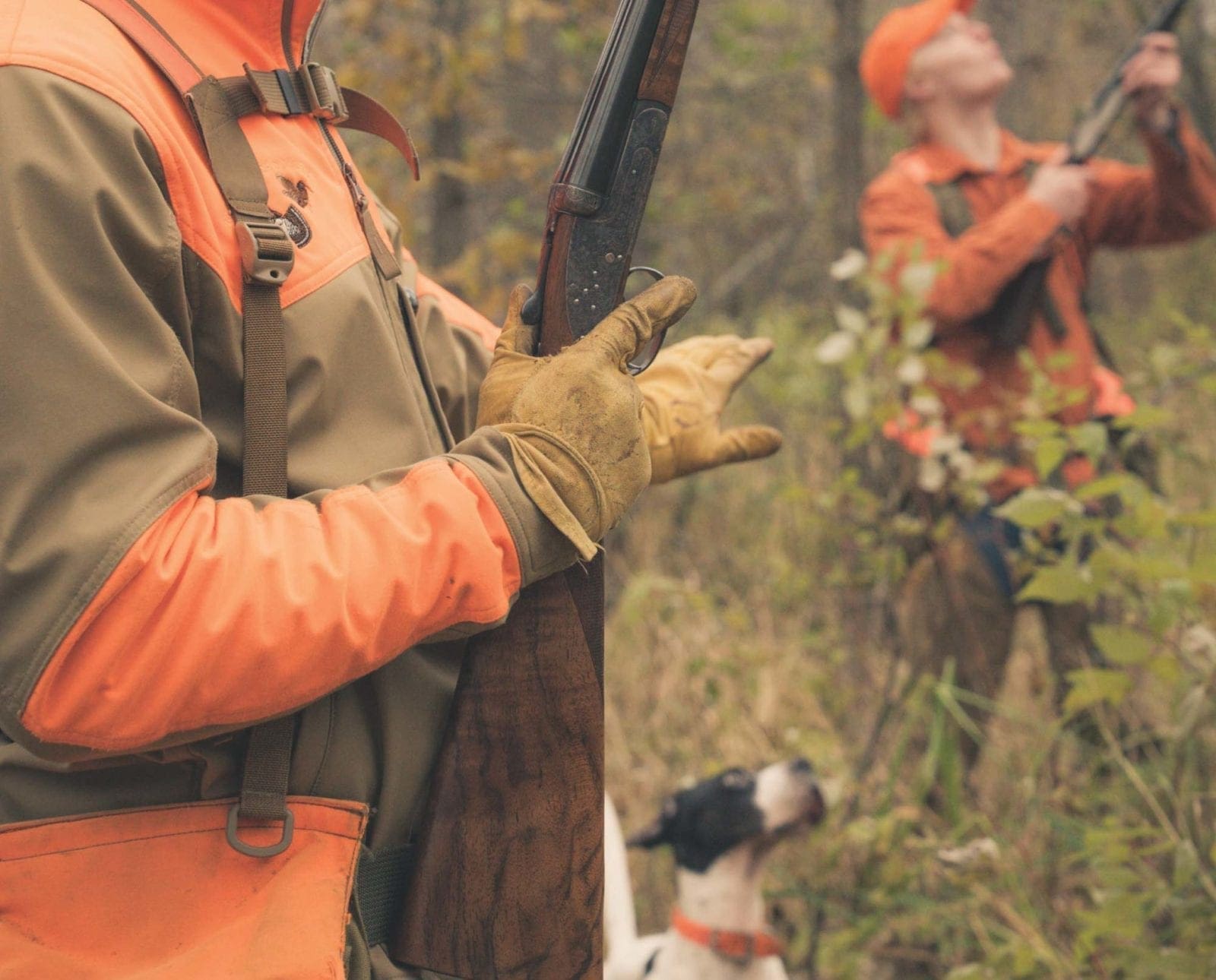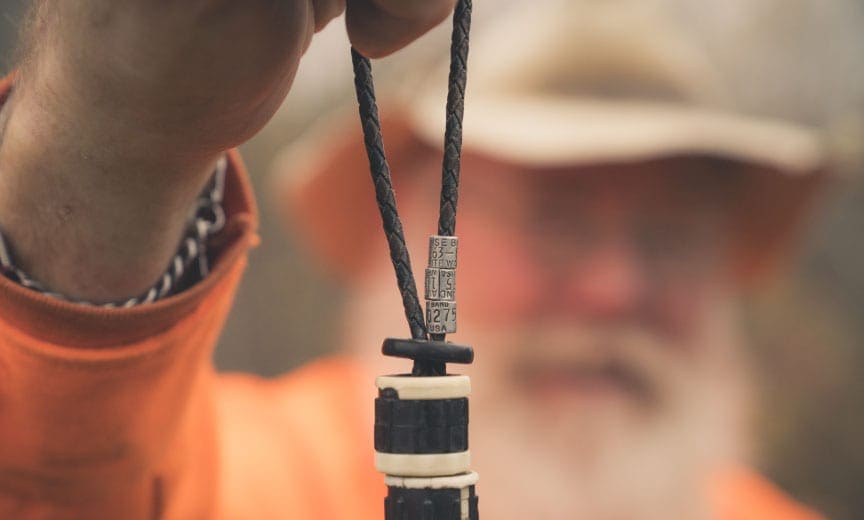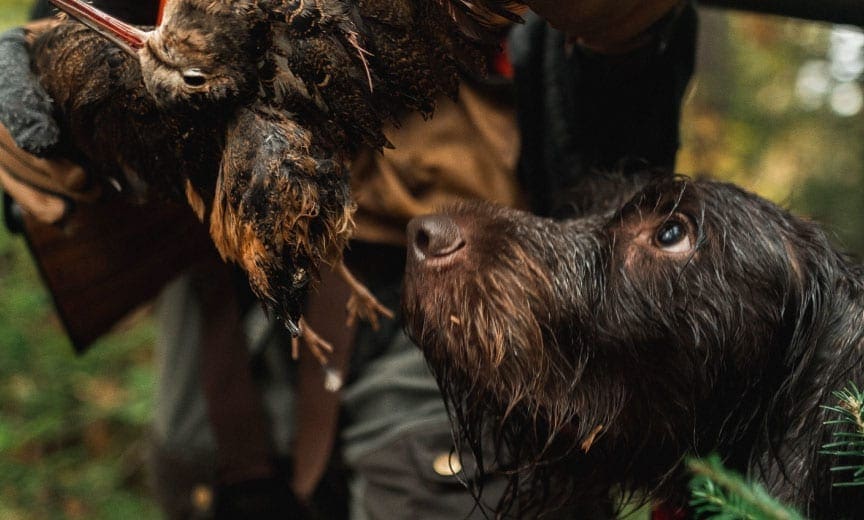Home » Woodcock Hunting » Why Woodcock are a Gun Dog’s Best Friend
Why Woodcock are a Gun Dog’s Best Friend

A.J. DeRosa, founder of Project Upland, is a New England…
Are woodcock the wild bird of choice to train dogs on the upcoming season?
We sat at the edge of the tailgate as legendary bird hunting guide “Earl the Pearl” lamented on the world of American woodcock and ruffed grouse hunting. His flush counter held the bands of multiple woodcock from over the years, a bit of a Holy Grail for us woodcock junkies. We talked of ruffed grouse but he would always wander back to those timber rockets (a term coined by the other Minnesota natives at Modern Wild).
“I like woodcock because they honor the dogs,” he suddenly said in a deliberate tone.

Reflecting on that statement, I often wondered if he worked on refining those words over the years to a simple an accurate depiction of what woodcock means to many of us. Sure, we often laugh over the fact that woodcock hold for dogs, but that in a way is the beauty and allure to them.
While working with a state DNR some years ago, they had expressed the idea that if they could get bird hunters excited about woodcock hunting they could spin that to eventually helping build excitement about trying to save wild bobwhite quail. Create bird hunters today with a game bird whose population is stable and you will inspire new conservation in the future, as well. An unusual plan, but as the state employee pointed out, they behave in a way like quail.
“Sure, they do not get up in a covey, but they hold for dogs,” he expressed out loud.
Once I got my own bird dog, my love for woodcock grew a bit more, though truth be told I was already obsessed with woodcock shooting. Woodcock are a tasty bird that provides for both good shooting days and bad, but all in the same spirit of good fun. Some birds are just cruel in the opportunities they present, but American woodcock is a great novice point for both hunter and dog alike.
Living in a part of the country that has suffered a severe decline in ruffed grouse, woodcock extends my season to places I cannot hunt wild birds. Without that, I would probably just end my season early. From the northern reaches of Maine and New Hampshire, down through Massachusetts and on to Connecticut each year, when the snow falls early up north, it really matters.
But my full love for woodcock did not come until my dog hit his third season. I had already steered away from running him on spring woodcock as there is plenty of science that pretty much points to key times you should not pressure the birds. I figured, let’s take the guess work out of it and just not do it anymore. That, however, still left the month of September wide open to brush up on training my dog before the October opener.

As my dog has aged and the list of things left to teach him have dwindled, I found myself at my trainer’s house very rarely. Having no ambition to add live birds to my house with a busy travel schedule, the need for wild birds to brush up on some steady work and to teach a dog properly has become more relevant.
A small woodcock cover not one mile from my house holds a fair amount of woodcock. It’s a consistent spot not too deep in the woods that can take just an hour out of my day from loading up to getting home. For me the idea of wild birds teaching my dog has always appealed to me and I’m by no means an expert. But I figured if all I do is hunt wild birds, well then I need them to teach my dog even when not hunting.
Then I spoke to Gregg Elliot of Dogs and Doubles as he headed to a preserve to train his pointers. I should note that I hold Gregg’s dogs up there as some of the most refined grouse dogs I’ve ever hunted over. Gregg in his pursuit of the perfect point has passed on many easy opportunities on ruffed grouse in my presence based on the slightest movement of his dog. My wirehaired pointing griffon and I are far less picky and a little more “meat” inclined.
“I control the situation by putting the birds in launchers. I do not need running preserve birds to mess up my dogs,” he said as we tried to make plans.
As I do with most friends, I offered up my sacred training cover to Gregg based on the promise of not shooting any birds out of it during the season. I knew he would oblige, and it would be helpful to him. You see, the comment about birds not running — that’s what is great about woodcock, that’s why they are a dog’s best friend when it comes to wild birds.
We can control the situation more so than with other wild birds, giving us ample opportunity to train, refine, and still give a wild bird flare to the experience. It teaches dogs what good cover looks like for future searches while allowing for steady training.
As I said before, my standards are far lighter than Gregg who often runs his dogs in field trials. For me, steady to flush is as far as I work so as to not embarrass myself as being anything more than a meat hunter. I swing my dog wide and take different trails to the cover, each time building up conditioning and adding a bit of variety to the chase. On days more time is available, I’ll move to other surrounding towns or explore new woodcock covers but always end on that cover so as to guarantee bird contacts before the day is through.
Over the years I’ve seen many hunters find their love for upland with woodcock. I’m sure the way their dog handled them, the thrill of walking up on a point, and the intensity of catching flight birds all play as factors in building a fascination with this under-credited upland game bird.

The folks from Modern Wild would tell you they found themselves the day they stumbled upon a flight of woodcock with their first dog after being tortured by ruffed grouse. Jay Dowd (aka Upland Lowlife), a very well-respected upland artist and guide, once said to me, “The woods become a bit lonelier when the woodcock migration is over” in what was sealed as a somber and captivating memory in my eyes. The consistency is a profound love for this well-behaved wild bird; although I have filmed and seen them walk away on many points, they keep us sane and are far more reasonable than their neighbors, the ruffed grouse.
As we set out in the woods with “Earl the Pearl,” his eyes lit up with every woodcock encounter, his expression visibly different than those grouse contacts. It was clear he targeted the birds most of the day pointing out key aspects of mating grounds, soil type, and vegetation age class. A biologist, a bird nerd, and like many of us obsessed with his four-legged companions, for him woodcock is a year-round obsession — from banding birds in the summer months to guiding with his army of English setters.
Maybe it would be more fitting to say that woodcock are a hunter’s and dog’s best third wheel.
A.J. DeRosa, founder of Project Upland, is a New England native with over 35 years of hunting experience across three continents. His passion for upland birds and side-by-side shotguns has taken him around the world, uncovering the stories of people and places connected to the uplands. First published in 2004, he wrote The Urban Deer Complex in 2014 and soon discovered a love for filmmaking, which led to the award-winning Project Upland film series. A.J.'s dedication to wildlife drives his advocacy for conservation policy and habitat funding at both federal and state levels. He serves as Vice Chair of the New Hampshire Fish & Game Commission, giving back to his community. You can often find A.J. and his Wirehaired Pointing Griffon, Grim, hunting in the mountains of New England—or wherever the birds lead them.




Spot on A.J. A very dog friendly gamebird especially for pointing dogs.
Very great insight , as I was preparing a spring run for my second season pup. Now, No. I will not pressure the birds at this spring season of nesting.